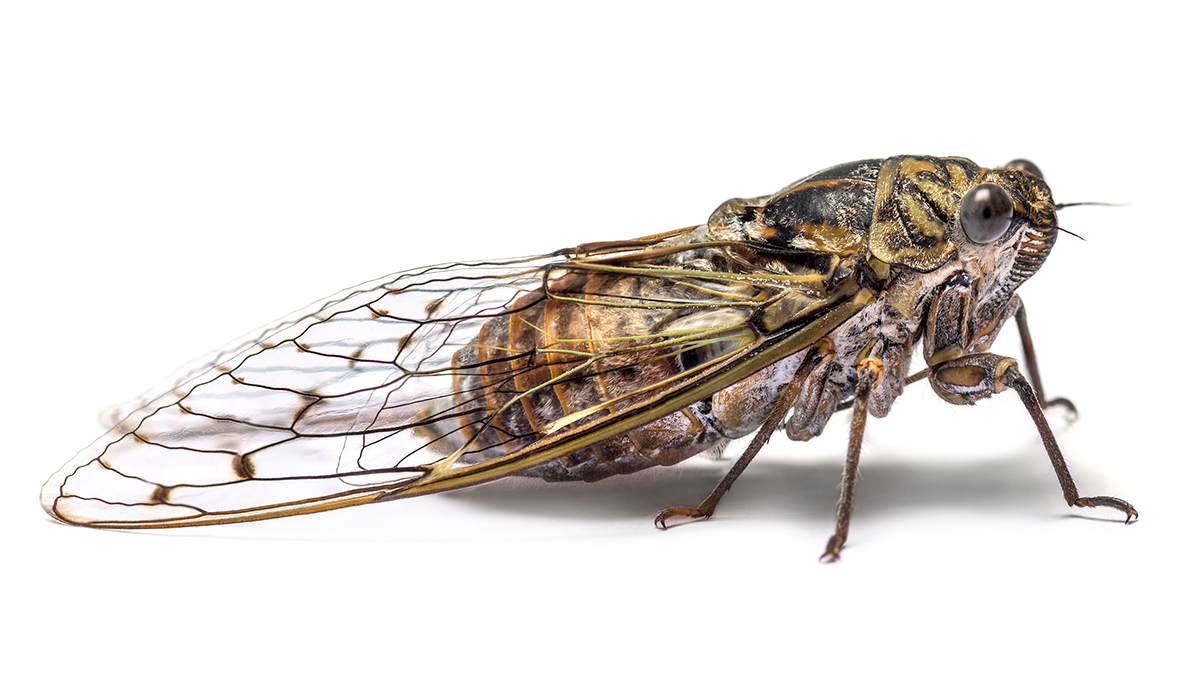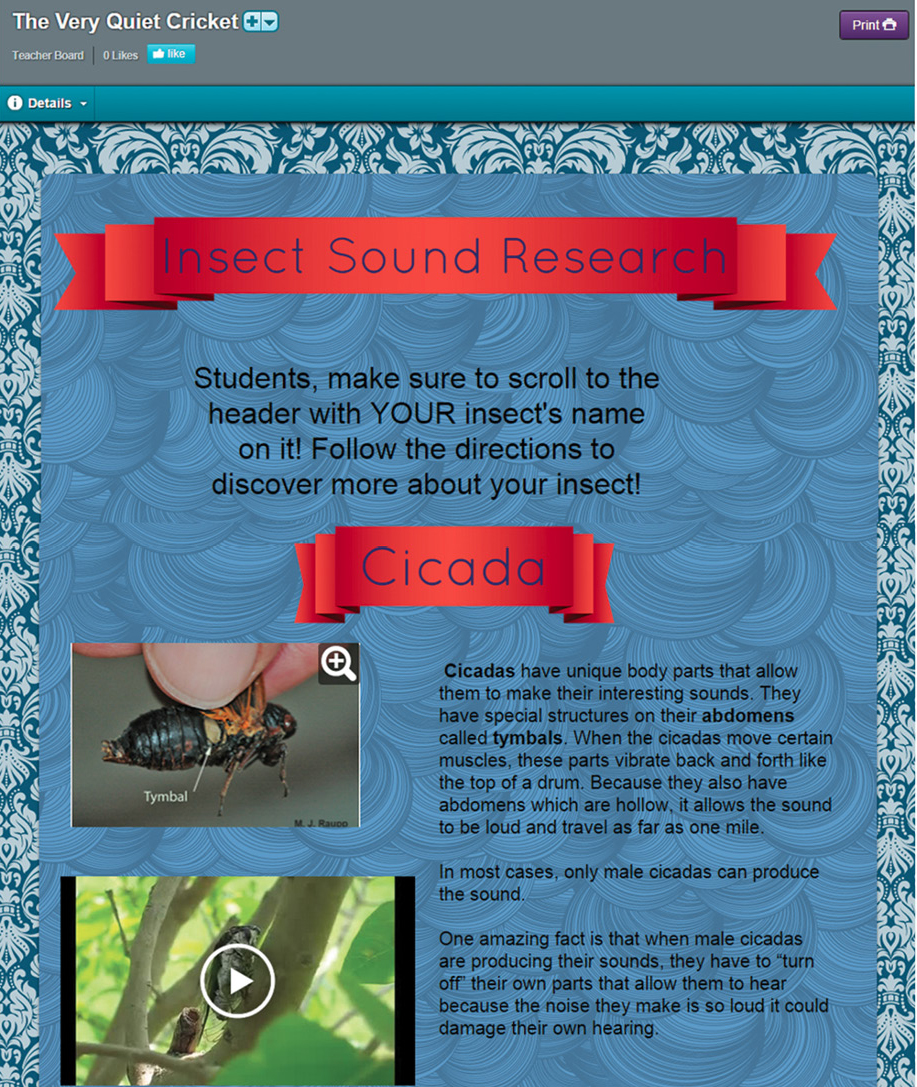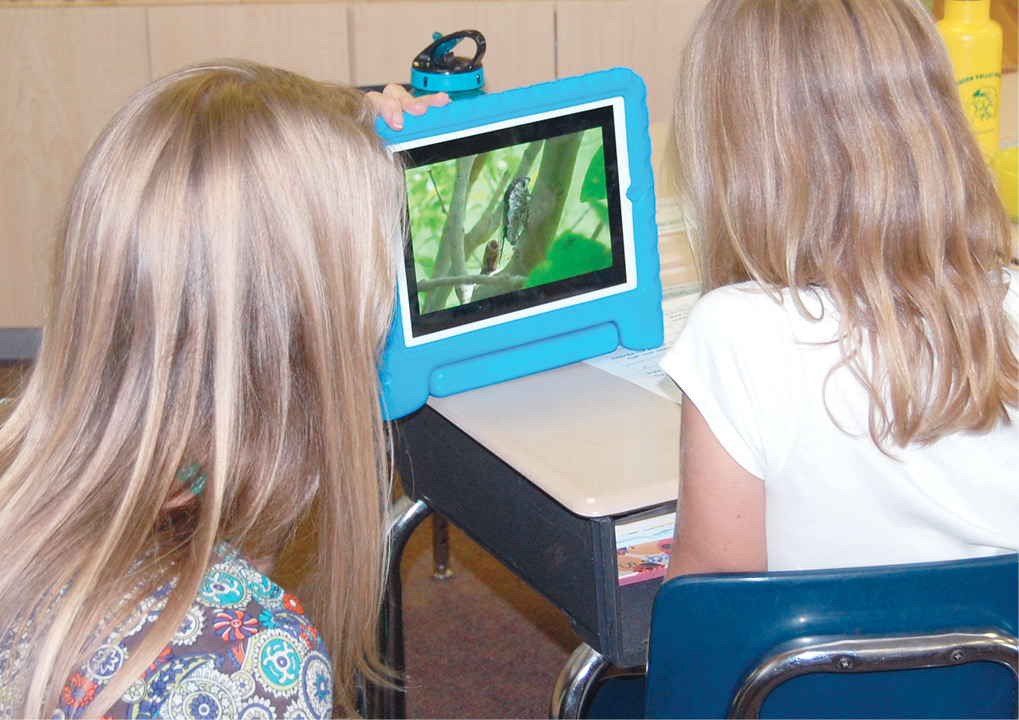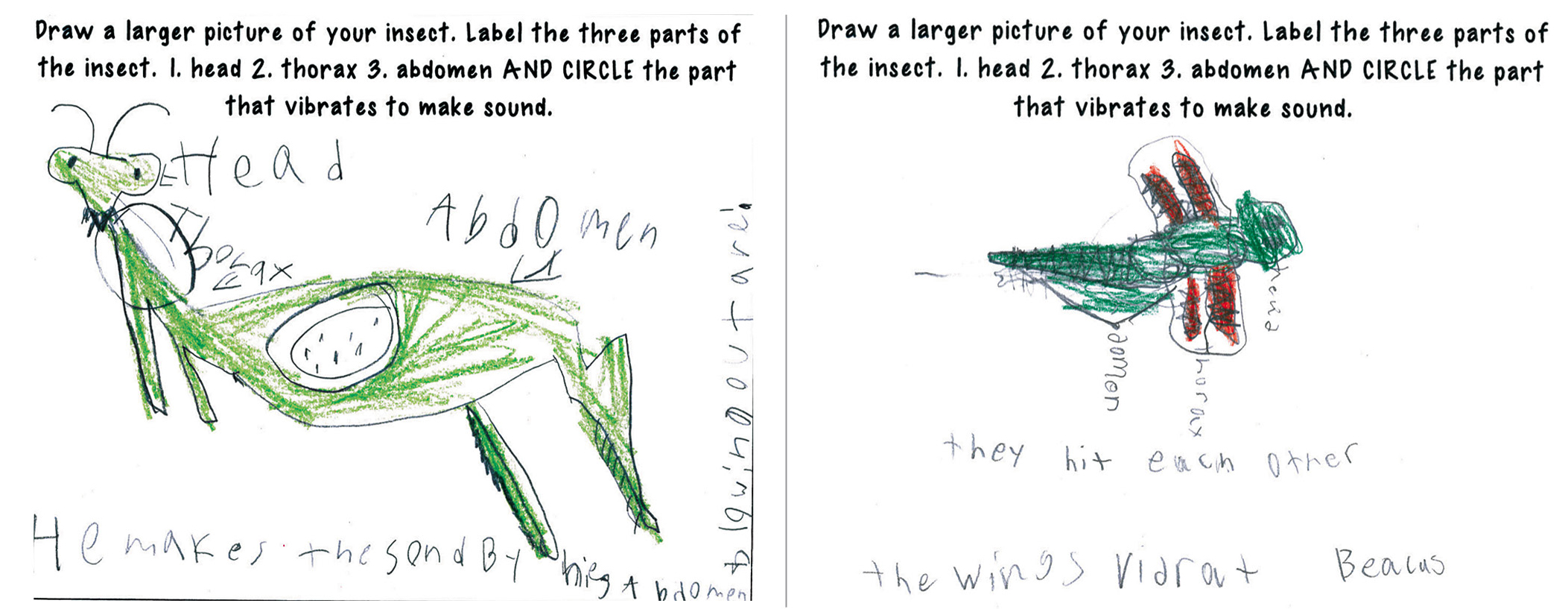feature
Vibrating Insects
An integrated multimodal unit on sound for early elementary students
Science and Children—March/April 2021 (Volume 58, Issue 4)
By Rachel Wilson, Leslie Bradbury, Amy Lunceford, and Shannon Stanbery

Covid-19 Distance Learning Options
While we recognize that the cooperative learning aspect of this lesson and being able to observe the acrylic specimens of the insects are important for student learning, some of the activities in this 5E can be accomplished in an online learning format.
Engage: The teacher can read The Very Quiet Cricket book during an online session.
Explore: The teacher can provide students with the data collection sheets, photographs of insects, and informational text resources online, and students could complete this activity at home (with help).
Explain: The teacher could provide students with the link to the board (which is already an online resource) and students could view this at home (with help) and fill out the data collection sheet.
The Explore and Explain activities should be followed by teacher-led discussions with students about what they observed and are thinking about related to their insect.
Expand/Elaborate: The students could look for and find household items (instead of teacher-provided items) to imitate their insect’s sound.
Evaluate: The teacher could provide students with the scaffolding sheet for their presentation. Students could present synchronously online, or present using a number of different technology tools (e.g., VoiceThread), depending on teacher and student skill level.
In working with the second-grade teachers at a local school, we designed a six-day integrated science and language arts unit to investigate the structures that insects use to make their sound vibrations. We were inspired by The Very Quiet Cricket (Carle 1990), which was used as the focus text for the unit, as well as Bug Music (Rothenberg 2013), which prompts readers to think about the noise that insects make as an inspiration for music. While Robertson and Meyer (2010) engaged middle grades students with the songs and sound wave images of various insects to teach about sound, we wanted to have concrete, physical examples to demonstrate sound energy vibrations to young learners. We designed a unit using multiple modes of representation for the insect body parts and their vibrations, including physical specimens, video, photographs, diagrams, and informational text. In addition, students represented their understanding using drawing, writing, and speaking. Using multiple modes of representation in the presentation to and production by students of science concepts is beneficial for early elementary students’ learning (Wilson and Bradbury 2016), as well as for supporting the science learning of students with learning disabilities (Taylor and Villanueva 2014). By including various visual representations (physical specimens, video, photographs, and diagrams) along with more traditional informational text, science information is made more accessible to developing and struggling readers.

Formative assessment probe.
Engage
Each day of this six-day unit included about an hour of instructional time. On the first day, we gave students a modified version of Keeley, Eberle, and Farrin’s (2005) “Making Sound” formative assessment probe (Figure 1) to see if students were making the connection that when insects make sound, they are vibrating something. We then discussed with students which objects vibrate or not when they make sound. We made a class list of things that do vibrate, maybe vibrate, and do not vibrate. The most common choices that students were unsure of included the praying mantis and the wind.

Class website example.
Then, the teacher read The Very Quiet Cricket (Carle 1990), which highlights common insects and the sounds they make, including a cricket, praying mantis, bumblebee, dragonfly, locust, and cicada. After reading the book, the teacher asked, “Which of these insects have you heard before? What ideas do you have about why insects make sound?” The teacher explained to the students that they would be put in groups to become an expert on one of six insects from the book and how that insect makes sound. As the final activity of the day, students observed acrylic coated preserved insect specimens of the six insects on trays throughout the room.
Explore
The focus question that students were trying to answer in the explore activity was: How do insects make sound? On the second day of the unit, students were placed into groups of three or four to research one of the six insects. Each group had at least one higher level reader and one lower level reader, as well as one or two grade level readers, so that struggling readers could be supported by their peers in the group in using the informational texts and writing. Each group received a preserved specimen and a photograph of their insect, plus hand lenses. Students observed their insect, drew it on their data collection sheet (see Supplementary Resources), predicted what sound their insect makes and where it lives, inferred how their insect moves (based on its body parts) and what it eats, and composed one question about their insect.
While walking around among student groups, we asked them questions to help them see why their organism was classified as an insect, notice any unique structures, elicit any prior experience with the insects, and begin to make connections between the structures of the insect and how they make noise. Some students noticed that all of the insects had wings, but they had never seen a praying mantis fly and wondered if it could. Students wondered if their insects lived in trees or in the ground. They also wondered if and how some of the insects differed from others they were familiar with (for example, honey bees and bumblebees, and crickets and locusts and grasshoppers).
Explain
After students got to know the structures of their insect, they gathered together on the class rug for a whole-class discussion, starting with the body parts that all insects share (six legs and three body segments). We displayed a diagram of a familiar insect, an ant, to point out what we meant by body segments and legs. We asked students to share what other body parts their insects had and which ones they thought might be involved in helping their insect to make sound. We also used this discussion as an opportunity to review what students had already learned about sound and vibrations to help them start making the connection that ANY sound involved vibrations made by an object (disciplinary core idea PS4.A, Wave Properties). Students mentioned that sounds are vibrations and that a force is needed to start a vibration. When needed, we asked them prompting questions about what body part the insect was moving to create a force that might start vibrations and sound waves. Most student groups were able to make this connection easily, but the praying mantis group in each class needed extra prompting to recognize that blowing air through holes also creates a vibration, similar to playing a wind instrument (e.g., flute or saxophone).
We began the third day by reading the book The Noisy Bug Sing Along, by John Himmelman (2003) to show examples of insects that make sounds, review characteristics of an insect, and reinforce that all of these insects used vibrations to make their sounds. Then we told students that they would be researching how their insect makes sound using videos, photographs, and informational texts, just like scientists do, by seeing what other scientists know about a topic. These multiple modes of information were compiled into one resource on a class website (Figure 2). The school had access to Discovery Education and so students were able to login and access their board, but we also were able to display the same information on a Padlet board. Padlet is a tool that anyone can use to create a multimedia, one-page website with text, photos, and videos, and thus, can be used to create a “board” similar to that on Discovery Education. Videos were chosen and edited so that students could see their insect moving and making their sound at the same time. The photographs showed students the body parts used in making the sound. We wrote text next to their video and photograph at a level accessible to the students. Each group of students had access to one iPad on which to view the board. While students viewed the board, they had a graphic organizer to help them keep track of the information they were learning about their insect (see Supplementary Resources), as well as a diagram of their insect and its structures. Students worked to research their insect, creating drawings of their insect and circling the parts used to make sound (Figure 3). While students worked, we visited groups to check for understanding and prompted students to describe the sound their insects made (Does it sound high or low to you? How would you describe your insect sound? How would you write that down? What letters does that sound like?).

A student conducts research online
When students had finished their research, we had them come back together on the rug for a discussion of their insect and how it made sound. Table 1 shows each insect and the body part(s) used to make their sound that we wanted students to notice in their video, photograph, and diagram. As each group talked about their insect, we made sure to reinforce the idea that whatever body parts that insect uses to make sound, the insect is exerting a force to cause the body part to vibrate, thus creating a sound. Each group was able to connect which body parts were involved in making noise, but some needed support in thinking of the body parts as vibrating. For example, the praying mantis group understood that air was pushed through the spiracles to create a hissing sound but did not think of the abdomen as vibrating. We concluded the Explain portion of the unit by revisiting the list of “sounds” from the assessment probe in the Engage stage and talking through the examples to make sure students understood what was vibrating to create the sounds.
Expand/Elaborate
On the fourth day, we explained to students that their task was to choose from a variety of objects to find one or more to make a similar sound to that of their insect. Materials that were made available included: kazoos, tissue paper, whistle, comb, baby food jar with beans or sand inside, plastic egg with marble inside, balloon, duct tape, zipper, paper to rip, wax paper. Students were encouraged to consult the web board to listen to their insect make sound. When students were ready to choose a material, they were asked to explain to the teacher why they were choosing that material before they were allowed to take it off the materials table. This scaffolding step helped to make sure students were thinking about how the material made a sound similar in pitch and volume to their insect. This activity also supports performance expectation 2-PS1-2: Analyze data obtained from testing different materials to determine which materials have the properties that are best suited for an intended purpose.
Evaluate
When each group had chosen their material, they were responsible for preparing a presentation about their insect to the rest of the class. Each group was given a scaffolding sheet for the presentation (see Supplementary Resources) focusing on the structures their insect used to make their sound, why their insect made sound, and two cool facts they wanted to share about their insect. After answering the questions on the scaffolding sheet, groups were given a poster board to draw their insect in its habitat. We stressed that the drawing of the insect should be large enough that they could show the class the structures that their insect used to make their sound. The students used part of the fourth day and the fifth day of the unit in preparations for their presentation.

Student drawings.
This was the first time the classes had made presentations. We stressed to students that they needed to introduce themselves and their insect, make their insect sound using their chosen material, use their poster drawing of their insect to point out the body parts used to make the sound, and show where that insect lived. Students were evaluated using a rubric to address both the science and speaking objectives (available in Supplementary Resources). The class presentations of their posters (Figure 4) took place on the sixth day of instruction. Students were excited to share what they had learned about their insect and how it made sound in their presentations. They were particularly curious about the cool facts that each group presented about their insect. For example, one of the bumblebee groups reported that it had a stinger, and the other students wanted to know if the bumblebee used its stinger on people and other insects. One of the dragonfly groups shared that they can eat small tadpoles, and the other students wondered if this meant that dragonflies could swim and could eat other aquatic animals.

Student poster.
After the groups presented their insects, we had a whole-class discussion related to what each insect had in common related to sound. We asked them about the purpose for insects making sound, to stress that insects use sound to communicate. We asked, “What did all of the insects have to do in order to be able to make a sound?” We wanted to reinforce the idea that insects have to vibrate a body part in order to make a sound. Many students shared that they had talked about their insects at home with family members, and one student even brought a cricket to school for us to look at in the hopes it would make noise and we could observe the vibrating body parts.
Conclusion
We chose insects as the focus of study for the sound unit because of their contribution of sounds to the natural world. Students loved the unit and mentioned that the specimens, the videos, the drawing, and the presentations were their favorite parts of the unit. ●
Print Resources
Carle, E. 1990. The very quiet cricket. New York: Philomel Books.
Himmelman, J. 2003. Noisy bug sing-along. Nevada City, CA: Dawn Publications.
Keeley, P., F. Eberle, and L. Farrin. 2005. Uncovering student ideas in science: 25 formative assessment probes, Vol. 1. Arlington, VA: NSTA Press.
Rothenberg, D. 2013. Bug music: How insects gave us rhythm and noise. New York: St. Martin’s Press.
Online Resources
Discovery Education: http://www.discoveryeducation.com
Padlet https://padlet.com
Praying mantis: (Suborder Mantodea): www.gardening-for-wildlife.com/praying-mantis.html
The secret of the cicada’s chirp: www.sciencemag.org/news/2013/06/secret-cicadas-chirp
Why do bees buzz? www.scientificamerican.com/article/why-do-bees-buzz/
Supplementary Resources
Download the data collection sheets and presentation rubric at https://bit.ly/378Cw54.
Rachel Wilson (wilsonre3@appstate.edu) is an associate professor, and Leslie Bradbury is a professor, both at Appalachian State University in Boone, North Carolina. Amy Lunceford, a former second-grade teacher, is an adjunct professor and the Teacher Education Program Manager at North Carolina Wesleyan College in Rocky Mount, North Carolina. Shannon Stanbery is a first-grade teacher at Green Valley School in Watauga County, North Carolina.
Biology Instructional Materials Life Science Literacy Elementary


